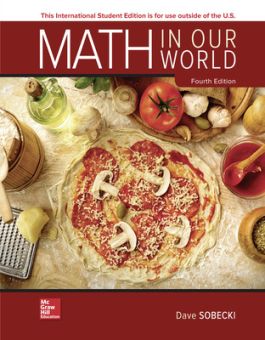The store will not work correctly when cookies are disabled.
-
Home
-
Math in Our World ISE
Content Area
Math in Our World ISE
4th Edition
1260290395
·
9781260290394
By David Sobecki
© 2019 | Published: January 2, 2018
After purchasing your eBook, login to the McGraw Hill Bookshelf website and redeem the access code from your order confirmation email.
- Access your eBook online or offline
- Easily highlight and take notes
- Fully searchable content
- Syncs across platforms
NOTE: eBook purchase does not include Connect homework or adaptive SmartBook assignments
> Learn more about McGraw Hill eBook
Mathematics in Our World, Fourth Edition
Chapter 1: Problem Solving
1-1 The Nature of Mathematical Reasoning
1-2 Estimation and Interpreting Graphs
1-3 Problem Solving Strategies
Chapter 1 Summary
Chapter 2: Sets
2-1 Introduction to Set Theory
2-2 Subsets and Set Operations
2-3 Using Venn Diagrams to Study Set Operations
2-4 Using Sets to Solve Problems
2-5 Infinite Sets
Chapter 2 Summary
Chapter 3: Logic
3-1 Statements and Quantifiers
3-2 Truth Tables
3-3 Types of Statements
3-4 Logical Arguments
3-5 Euler Circles
Chapter 3 Summary
Chapter 4: Numeration Systems
4-1 Early and Modern Numeration Systems
4-2 Tools and Algorithms in Arithmetic
4-3 Base Number Systems
4-4 Operations in Base Number Systems
Chapter 4 Summary
Chapter 5: The Real Number System
5-1 The Natural Numbers
5-2 The Integers
5-3 The Rational Numbers
5-4 The Irrational Numbers
5-5 The Real Numbers
5-6 Exponents and Scientific Notation
5-7 Arithmetic and Geometric Sequences
Chapter 5 Summary
Chapter 6: Topics in Algebra
6-1 Applications of Linear Equations
6-2 Ratio, Proportion, and Variation
6-3 The Rectangular Coordinate System and Linear Equations in Two Variables
6-4 Functions
6-5 Quadratic, Exponential, and Logarithmic Functions
Chapter 6 Summary
Chapter 7: Consumer Mathematics
7-1 Percents
7-2 Personal Budgeting
7-3 Simple Interest
7-4 Compound Interest
7-5 Installment Buying
7-6 Student Loans and Home Buying
7-7 Investing in Stocks and Bonds
Chapter 7 Summary
Chapter 8: Measurement
8-1 Measures of Length: Converting Units and the Metric System
8-2 Measures of Area, Volume, and Capacity
8-3 Measures of Weight and Temperature
Chapter 8 Summary
Chapter 9: Geometry
9-1 Points, Lines, Planes and Angles
9-2 Triangles
9-3 Polygons and Perimeter
9-4 Areas of Polygons and Circles
9-5 Volume and Surface Area
9-6 Right Triangle Trigonometry
9-7 A Brief Survey of Non-Euclidean and Other Geometries
Chapter 9 Summary
Chapter 10: Probability and Counting Techniques
10-1 The Fundamental Counting Principle and Permutations
10-2 Combinations
10-3 Basic Concepts of Probability
10-4 Tree Diagrams, Tables, and Sample Spaces
10-5 Probability Using Permutations and Combinations
10-6 Odds and Expectation
10-7 The Addition Rules for Probability
10-8 The Multiplication Rules and Conditional Probability
10-9 The Binomial Distribution
Chapter 10 Summary
Chapter 11: Statistics
11-1 Gathering and Organizing Data
11-2 Picturing Data
11-3 Measures of Average
11-4 Measures of Variation
11-5 Measures of Position
11-6 The Normal Distribution
11-7 Applications of the Normal Distribution
11-8 Correlation and Regression Analysis
Supplement: Misuses of Statistics
Chapter 11 Summary
Chapter 12: Voting Methods
12-1 Preference Tables and the Plurality Method
12-2 The Borda Count Method and the Plurality-with-Elimination Method
12-3 The Pairwise Comparison Method and Approval Voting
12-4 Apportionment
12-5 Apportionment Flaws
Chapter 12 Summary
Chapter 13: Graph Theory
13-1 Basic Concepts of Graph Theory
13-2 Euler’s Theorem
13-3 Hamilton Paths and Circuits
13-4 Trees
Chapter 13 Summary
Chapter 14-Available online: Other Mathematical Systems
14-1 Mathematical Systems and Groups
14-2 Clock Arithmetic
14-3 Modular Systems
Chapter 14 Summary
Appendix A: Area Under the Standard Normal Distribution
Appendix B-Available Online: Using the TI-84 Plus Graphing Calculator
Selected Answers
Photo Credits
Index

